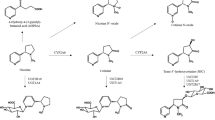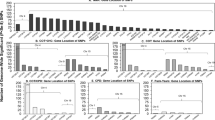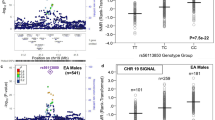Abstract
We investigated the effect of slow metabolism of nicotine, predicted by CYP2A6 genotypes resulting in ⩽50% activity, on baseline smoking behaviours and treatment variables in an open-label nicotine replacement therapy (NRT) clinical trial. Caucasian smokers with CYP2A6 slow vs normal metabolism had lower metabolic activity, indicated by the 3-hydroxycotinine/cotinine ratio (0.23±0.17 vs 0.45±0.22, P<0.01, respectively). CYP2A6 slow metabolizers also smoked fewer cigarettes per day compared to normal metabolizers (20±7 vs 24±10, respectively, P<0.04). With nicotine patch use, slow metabolizers had higher nicotine plasma levels compared to normal metabolizers (22.8±4.6 vs 15.8±7.6 ng/ml, respectively, P=0.02) while using the same numbers of patches/week. With nicotine spray use, where like in smoking the nicotine intake can be easily adjusted to adapt to rates of metabolism, slow metabolizers achieved similar nicotine levels compared to normal metabolizers (5.8±4.1 vs 8.0±9.1 ng/ml, P=0.82), by using fewer doses of nicotine spray/day (4.8±3.6 vs 10.5±8.0, respectively, P<0.02). These findings indicate that CYP2A6 genotype influences smoking behaviour in a Caucasian treatment-seeking population and that CYP2A6 genotype affects plasma levels obtained from, and usage of, NRT.
This is a preview of subscription content, access via your institution
Access options
Subscribe to this journal
Receive 12 print issues and online access
$259.00 per year
only $21.58 per issue
Buy this article
- Purchase on Springer Link
- Instant access to full article PDF
Prices may be subject to local taxes which are calculated during checkout





Similar content being viewed by others
References
Benowitz NL, Jacob III P . Metabolism of nicotine to cotinine studied by a dual stable isotope method. Clin Pharmacol Ther 1994; 56: 483–493.
Messina ES, Tyndale RF, Sellers EM . A major role for CYP2A6 in nicotine C-oxidation by human liver microsomes. J Pharmacol Exp Ther 1997; 282: 1608–1614.
Nakajima M, Yamamoto T, Nunoya K, Yokoi T, Nagashima K, Inoue K et al. Role of human cytochrome P4502A6 in C-oxidation of nicotine. Drug Metab Dispos 1996; 24: 1212–1217.
Dempsey D, Tutka P, Jacob III P, Allen F, Schoedel K, Tyndale RF et al. Nicotine metabolite ratio as an index of cytochrome P450 2A6 metabolic activity. Clin Pharmacol Ther 2004; 76: 64–72.
Nakajima M, Yamamoto T, Nunoya K, Yokoi T, Nagashima K, Inoue K et al. Characterization of CYP2A6 involved in 3′-hydroxylation of cotinine in human liver microsomes. J Pharmacol Exp Ther 1996; 277: 1010–1015.
Benowitz NL, Tyndale RF, Jacob III P, Swan GE . CYP2A6 polymorphisms and nicotine metabolism. Clin Pharmacol Ther 2002; 71: 41.
Xu C, Rao YS, Xu B, Hoffmann E, Jones J, Sellers EM et al. An in vivo pilot study characterizing the new CYP2A6*7, *8, and *10 alleles. Biochem Biophys Res Commun 2002; 290: 318–324.
Rao Y, Hoffmann E, Zia M, Bodin L, Zeman M, Sellers EM et al. Duplications and defects in the CYP2A6 gene: identification, genotyping, and in vivo effects on smoking. Mol Pharmacol 2000; 58: 747–755.
Benowitz NL, Jacob III P . Nicotine renal excretion rate influences nicotine intake during cigarette smoking. J Pharmacol Exp Ther 1985; 234: 153–155.
Zacny JP, Stitzer ML . Cigarette brand-switching: effects on smoke exposure and smoking behavior. J Pharmacol Exp Ther 1988; 246: 619–627.
Nakajima M, Yamagishi S, Yamamoto H, Yamamoto T, Kuroiwa Y, Yokoi T . Deficient cotinine formation from nicotine is attributed to the whole deletion of the CYP2A6 gene in humans. Clin Pharmacol Ther 2000; 67: 57–69.
Ariyoshi N, Miyamoto M, Umetsu Y, Kunitoh H, Dosaka-Akita H, Sawamura Y et al. Genetic polymorphism of CYP2A6 gene and tobacco-induced lung cancer risk in male smokers. Cancer Epidemiol Biomarkers Prev 2002; 11: 890–894.
Iwahashi K, Waga C, Takimoto T . Whole deletion of CYP2A6 gene (CYP2A6AST;4C) and smoking behavior. Neuropsychobiology 2004; 49: 101–104.
Minematsu N, Nakamura H, Iwata M, Tateno H, Nakajima T, Takahashi S et al. Association of CYP2A6 deletion polymorphism with smoking habit and development of pulmonary emphysema. Thorax 2003; 58: 623–628.
Schoedel K, Hoffmann E, Rao Y, Sellers E, Tyndale RF . Ethnic variation in CYP2A6 and association of genetically slow nicotine metabolism and smoking in adult Caucasians. Pharmacogenetics 2004; 14: 615–626.
Goodz S, Alhuwalia J, Harris K, Xu C, Rao YS, Xu B et al. CYP2A6 genetic variants among African-Americans. Abstract presentation at the Society for Research on Nicotine and Tobacco meeting, Savanna, GA, 2002 (Published only in meeting proceedings).
Fujieda M, Yamazaki H, Saito T, Kiyotani K, Gyamfi MA, Sakurai M et al. Evaluation of CYP2A6 genetic polymorphisms as determinants of smoking behavior and tobacco-related lung cancer risk in male Japanese smokers. Carcinogenesis 2004; 25: 2451–2458.
London SJ, Idle JR, Daly AK, Coetzee GA . Genetic variation of CYP2A6, smoking, and risk of cancer. Lancet 1999; 353: 898–899.
Loriot MA, Rebuissou S, Oscarson M, Cenee S, Miyamoto M, Ariyoshi N et al. Genetic polymorphisms of cytochrome P450 2A6 in a case–control study on lung cancer in a French population. Pharmacogenetics 2001; 11: 39–44.
Sabol SZ, Hamer DH . An improved assay shows no association between the CYP2A6 gene and cigarette smoking behaviour. Behav Genet 1999; 157: 632–634.
Ando M, Hamajima N, Ariyoshi N, Kamataki T, Matsuo K, Ohno Y . Association of CYP2A6 gene deletion with cigarette smoking status in Japanese adults. J Epidemiol 2003; 13: 176–181.
O'Loughlin J, Paradis G, Kim W, DiFranza J, Meshefedjian G, McMillan-Davey E et al. Genetically decreased CYP2A6 and the risk of tobacco dependence: a prospective study of novice smokers. Tobacco Control 2004; 13: 422–428.
McGoven PG, Lando HA, Roski J, Pirie PL, Sprafka JM . A comparison of smoking cessation clinic participants with smokers in the general population. Tobacco Control 1994; 3: 329–333.
Fagerstrom KO, Kunze M, Schoberberger R, Breslau N, Hughes JR, Hurt RD et al. Nicotine dependence versus smoking prevalence: comparisons among countries and categories of smokers. Tobacco Control 1996; 5: 52–56.
Fiore MC . US public health service clinical practice guideline: treating tobacco use and dependence. Respir Care 2000; 45: 1200–1262.
Fant RV, Owen LL, Henningfield JE . Nicotine replacement therapy. Primary Care 1999; 26: 633–652.
Levin ED, Westman EC, Stein RM, Carnahan E, Sanchez M, Herman S et al. Nicotine skin patch treatment increases abstinence, decreases withdrawal symptoms, and attenuates rewarding effects of smoking. J Clin Psychopharmacol 1994; 14: 41–49.
Benowitz NL, Zevin S, Jacob III P . Sources of variability in nicotine and cotinine levels with use of nicotine nasal spray, transdermal nicotine, and cigarette smoking. Br J Clin Pharmacol 1997; 43: 259–267.
Hurt RD, Dale LC, Offord KP, Lauger GG, Baskin LB, Lawson GM et al. Serum nicotine and cotinine levels during nicotine-patch therapy. Clin Pharmacol Ther 1993; 54: 98–106.
Jones RL, Nguyen A, Man SF . Nicotine and cotinine replacement when nicotine nasal spray is used to quit smoking. Psychopharmacology (Berlin) 1998; 137: 345–350.
Xu C, Goodz S, Sellers EM, Tyndale RF . CYP2A6 genetic variation and potential consequences. Adv Drug Deliv Rev 2002; 54: 1245–1256.
Malaiyandi V, Sellers EM, Tyndale RF . Implications of CYP2A6 genetic variation for smoking behaviors and nicotine dependence. Clin Pharmacol Ther 2005; 77: 145–158.
Dale LC, Hurt RD, Offord KP, Lawson GM, Croghan IT, Schroeder DR . High-dose nicotine patch therapy. Percentage of replacement and smoking cessation. JAMA 1995; 274: 1353–1358.
Jorenby DE, Smith SS, Fiore MC, Hurt RD, Offord KP, Croghan IT et al. Varying nicotine patch dose and type of smoking cessation counseling. JAMA 1995; 274: 1347–1352.
Hadidi H, Zahlsen K, Idle JR, Cholerton S . A single amino acid substitution (Leu160His) in cytochrome P450 CYP2A6 causes switching from 7-hydroxylation to 3-hydroxylation of coumarin. Food Chem Toxicol 1997; 35: 903–907.
Kiyotani K, Yamazaki H, Fujieda M, Iwano S, Matsumura K, Satarug S et al. Decreased coumarin 7-hydroxylase activities and CYP2A6 expression levels in humans caused by genetic polymorphism in CYP2A6 promoter region (CYP2A6*9). Pharmacogenetics 2003; 13: 689–695.
Oscarson M, McLellan RA, Asp V, Ledesma M, Ruiz ML, Sinues B et al. Characterization of a novel CYP2A7/CYP2A6 hybrid allele (CYP2A6*12) that causes reduced CYP2A6 activity. Hum Mutat 2002; 20: 275–283.
Nakajima M, Kwon JT, Tanaka N, Zenta T, Yamamoto Y, Yamamoto H et al. Relationship between interindividual differences in nicotine metabolism and CYP2A6 genetic polymorphism in humans. Clin Pharmacol Ther 2001; 69: 72–78.
Yoshida R, Nakajima M, Nishimura K, Tokudome S, Kwon JT, Yokoi T . Effects of polymorphism in promoter region of human CYP2A6 gene (CYP2A6*9) on expression level of messenger ribonucleic acid and enzymatic activity in vivo and in vitro. Clin Pharmacol Ther 2003; 74: 69–76.
Goodz SD, Tyndale RF . Genotyping human CYP2A6 variants. Methods Enzymol 2002; 357: 59–69.
Lerman C, Kaufmann V, Rukstalis M, Patterson F, Perkins K, Audrain-McGovern J et al. Individualizing nicotine replacement therapy for the treatment of tobacco dependence: a randomized trial. Ann Intern Med 2004; 140: 426–433.
Lerman C, Wileyto EP, Patterson F, Rukstalis M, Audrain-McGovern J, Restine S et al. The functional mu opioid receptor (OPRM1) Asn40Asp variant predicts short-term response to nicotine replacement therapy in a clinical trial. Pharmacogenom J 2004; 4: 184–192.
Benowitz NL, Perez-Stable EJ, Fong I, Modin G, Herrera B, Jacob III P . Ethnic differences in N-glucuronidation of nicotine and cotinine. J Pharmacol Exp Ther 1999; 291: 1196–1203.
Haberl M, Anwald B, Klein K, Weil R, Fu C, Gepdiremen A et al. Three haplotypes associated with CYP2A6 phenotypes in Caucasians. Pharmacogenet Genomics 2005; 15: 609–624.
Hukkanen J, Jacob III P, Benowitz NL . Metabolism and disposition kinetics of nicotine. Pharmacol Rev 2005; 57: 79–115.
Gu DF, Hinks LJ, Morton NE, Day IN . The use of long PCR to confirm three common alleles at the CYP2A6 locus and the relationship between genotype and smoking habit. Ann Hum Genet 2000; 64: 383–390.
Broms U, Silventoinen K, Lahelma E, Koskenvuo M, Kaprio J . Smoking cessation by socioeconomic status and marital status: the contribution of smoking behavior and family background. Nicotine Tobacco Res 2004; 6: 447–455.
Ferguson JA, Patten CA, Schroeder DR, Offord KP, Eberman KM, Hurt RD . Predictors of 6-month tobacco abstinence among 1224 cigarette smokers treated for nicotine dependence. Addict Behav 2003; 28: 1203–1218.
McKee SA, O'Malley SS, Salovey P, Krishnan-Sarin S, Mazure CM . Perceived risks and benefits of smoking cessation: gender-specific predictors of motivation and treatment outcome. Addict Behav 2005; 30: 423–435.
Perkins KA . Smoking cessation in women. Special considerations. CNS Drugs 2001; 15: 391–411.
Westmaas JL, Langsam K . Unaided smoking cessation and predictors of failure to quit in a community sample: effects of gender. Addict Behav 2005; 30: 1405–1424.
Batra V, Patkar AA, Berrettini WH, Weinstein SP, Leone FT . The genetic determinants of smoking. Chest 2003; 123: 1730–1739.
Lerman C, Berrettini W . Elucidating the role of genetic factors in smoking behavior and nicotine dependence. Am J Med Genet 2003; 118B: 48–54.
Tyndale RF . Genetics of alcohol and tobacco use in humans. Ann Med 2003; 35: 94–121.
Daughton DM, Fortmann SP, Glover ED, Hatsukami DK, Heatley SA, Lichtenstein E et al. The smoking cessation efficacy of varying doses of nicotine patch delivery systems 4–5 years post-quit day. Prev Med 1999; 28: 113–118.
Law MR, Morris JK, Watt HC, Wald NJ . The dose–response relationship between cigarette consumption, biochemical markers and risk of lung cancer. Br J Cancer 1997; 75: 1690–1693.
Strasser AA, Kaufmann V, Jepson C, Perkins KA, Pickworth WB, Wileyto EP et al. Effects of different nicotine replacement therapies on postcessation psychological responses. Addict Behav 2005; 30: 9–17.
Strasser AA, Malaiyandi V, Lerman C, Tyndale RF . Differences in smoking topography associated with CYP2A6 genotype. Soc Res Nicotine Tobacco 2005; 7: 704.
Bergen AW, Caporaso N . Cigarette smoking. J Natl Cancer Inst 1999; 91: 1365–1375.
Benowitz NL, Kuyt F, Jacob III P . Circadian blood nicotine concentrations during cigarette smoking. Clin Pharmacol Ther 1982; 32: 758–764.
Benowitz NL, Pomerleau OF, Pomerleau CS, Jacob III P . Nicotine metabolite ratio as a predictor of cigarette consumption. Nicotine Tobacco Res 2003; 5: 621–624.
Jarvik ME, Madsen DC, Olmstead RE, Iwamoto-Schaap PN, Elins JL, Benowitz NL . Nicotine blood levels and subjective craving for cigarettes. Pharmacol Biochem Behav 2000; 66: 553–558.
Zubieta JK, Heitzeg MM, Xu Y, Koeppe RA, Ni L, Guthrie S et al. Regional cerebral blood flow responses to smoking in tobacco smokers after overnight abstinence. Am J Psychiatry 2005; 162: 567–577.
Balfour D, Benowitz N, Fagerstrom K, Kunze M, Keil U . Diagnosis and treatment of nicotine dependence with emphasis on nicotine replacement therapy. A status report. Eur Heart J 2000; 21: 438–445.
George TP, O'Malley SS . Current pharmacological treatments for nicotine dependence. Trends Pharmacol Sci 2004; 25: 42–48.
Gourlay SG, Benowitz NL, Forbes A, McNeil JJ . Determinants of plasma concentrations of nicotine and cotinine during cigarette smoking and transdermal nicotine treatment. Eur J Clin Pharmacol 1997; 51: 407–414.
Runkel M, Bourian M, Tegtmeier M, Legrum W . The character of inhibition of the metabolism of 1,2-benzopyrone (coumarin) by grapefruit juice in human. Eur J Clin Pharmacol 1997; 53: 265–269.
Madan A, Graham RA, Carroll KM, Mudra DR, Burton LA, Krueger LA et al. Effects of prototypical microsomal enzyme inducers on cytochrome P450 expression in cultured human hepatocytes. Drug Metab Dispos 2003; 31: 421–431.
Acknowledgements
This work was supported by a CIHR Grant MOP 53248, the Centre for Addiction and Mental Health (RFT), a Transdisciplinary Tobacco Use Research Center Grant from the National Cancer Institute and the National Institute on Drug Abuse P5084718, the Abramson Cancer Center and Annenberg Public Policy Center (CL), PHS Grants DA02277, DA12393, CA078703, and the UCSF Comprehensive Cancer Center (NB), and a Public Health Services Research Grant M01-RR0040 from the National Institutes of Health. We would like to acknowledge the technical support of Ewa Hoffmann, Yushu Rao and Bo Xu. We also acknowledge the support of a CIHR-STPTR award (VM) and a Canada Research Chair in Pharmacogenetics (RFT). Nicotine nasal spray (Nicotrol®) was provided by Pharmacia, Helsingborg, Sweden.
Author information
Authors and Affiliations
Corresponding author
Rights and permissions
About this article
Cite this article
Malaiyandi, V., Lerman, C., Benowitz, N. et al. Impact of CYP2A6 genotype on pretreatment smoking behaviour and nicotine levels from and usage of nicotine replacement therapy. Mol Psychiatry 11, 400–409 (2006). https://doi.org/10.1038/sj.mp.4001794
Received:
Revised:
Accepted:
Published:
Issue Date:
DOI: https://doi.org/10.1038/sj.mp.4001794
Keywords
This article is cited by
-
Association of genetic polymorphisms CYP2A6*2 rs1801272 and CYP2A6*9 rs28399433 with tobacco-induced lung Cancer: case-control study in an Egyptian population
BMC Cancer (2018)
-
Precision Medicine for Tobacco Dependence: Development and Validation of the Nicotine Metabolite Ratio
Journal of Neuroimmune Pharmacology (2016)
-
Biomarkers of Response to Smoking Cessation Pharmacotherapies: Progress to Date
CNS Drugs (2015)
-
The Genetics, Neurogenetics and Pharmacogenetics of Addiction
Current Behavioral Neuroscience Reports (2014)
-
Biomarkers for Smoking Cessation
Clinical Pharmacology & Therapeutics (2013)



